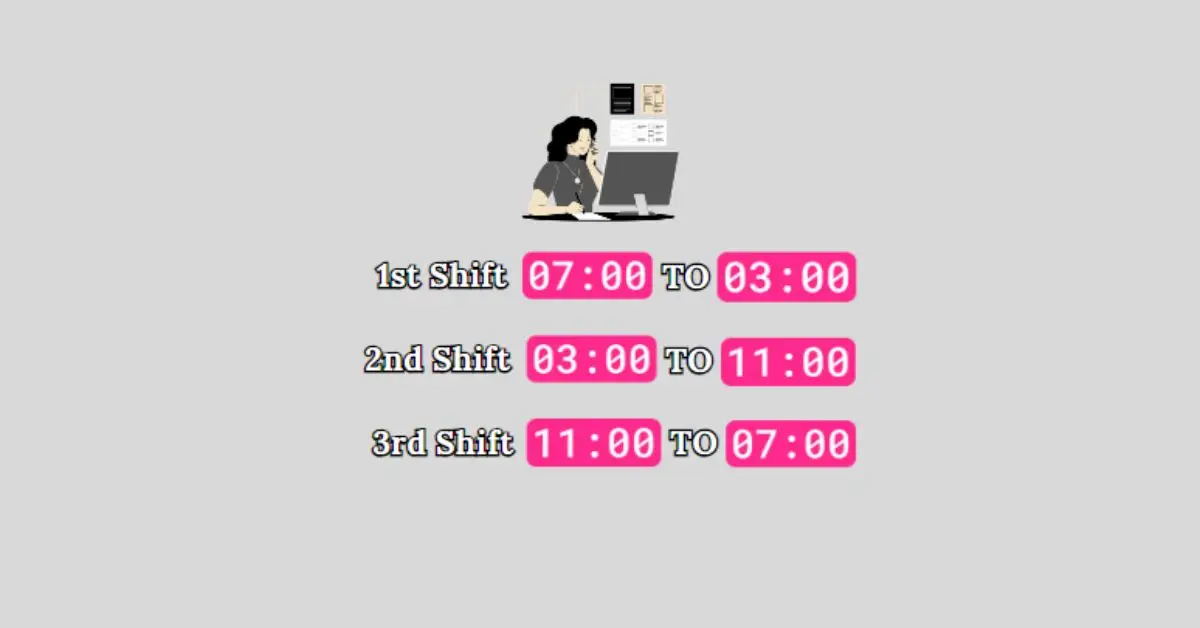
1st, 2nd, and 3rd Shift Hours: The Complete Breakdown
Shift work is pretty common in industries where they operate beyond the usual 9-5 (mostly applicable for 24/7 businesses). Places like hospitals, factories, call centers, and shipping companies often have people working 1st, 2nd, and 3rd shift hours to keep things running smoothly all day and night.
These different shifts help ensure continuous operations without any disruptions. Moreover, they help enhance productivity around the clock. So, both employers and workers need to get a clear idea about these shifts to make informed choices regarding work schedules, productivity, and work-life balance.
This article will cover:
- What are the 1st, 2nd, and 3rd shifts and their typical hours?
- Common jobs associated with each shift.
- The benefits and drawbacks of each shift and how they help employees and employers navigate the best options.
- How AI tools help optimize shift schedules.
1st Shift
The 1st shift is the most common one in many organizations and it aligns well with usual business hours. Let’s understand it in detail.

What is 1st Shift?
The first shift is simply known as the day shift. This is because it is mainly day-oriented and perfectly falls within the usual working schedule of the majority of organizations. This shift has no major change as the employees work during the day and have the evenings for their other activities.
1st Shift Hours
1st shift hours are between 7 AM to 3 PM or 9 AM to 5 PM. This shift particularly offers a consistent schedule for employees that aligns with most services and facilities. This simplifies running errands, attending appointments, and participating in social activities.
Common 1st Shift Jobs
Some common jobs that operate during the 1st shift include:
- Office and administrative roles
- Retail positions
- Healthcare roles like doctors and therapists
- Teachers and educational staff
- Customer service representatives in daytime call centers
1st Shift Benefits
- Regular Timings: 1st shift is the most convenient shift and it usually aligns with business hours.
- Work-Life Balance: Employees have their evenings free for personal and family time. Plus getting off days is also less complex.
- Access to Facilities: Since most services like banks and clinics operate during this time, employees find it easy to manage their work tasks.
1st Shift Drawbacks
- High Competition: Many people prefer this shift and it makes jobs more competitive.
- Traffic Congestion: Peak rush hours can be stressful and increase commute times.
- Limited Flexibility: The standard schedule may not offer flexibility for employees who seek alternative hours.
2nd Shift
This shift is also known as the afternoon shift which is between the day and night shifts. Let's understand it comprehensively.

What is 2nd Shift?
It is the shift whereby the employees are expected to start work within the middle of the day (that is, late afternoon or early evening). This shift aims to enable the firms to open to their clients during the busiest period, which covers several hours after the normal business operating hours. This shift is common in industries like manufacturing, customer service, and logistics.
2nd Shift Hours
Most of the time, 2nd shift hours commence at 3 PM and finish at 11 PM or the other way starting at 4 PM and ending at 12 AM the midnight. It is positioned to bridge the available work hours between the first and third shifts.
Common 2nd Shift Jobs
Examples of 2nd shift jobs include:
- Customer service representatives (especially for late-hour support)
- Production workers in factories
- Warehouse and inventory workers
- Restaurant staff for dinner service
- Healthcare staff such as nurses
2nd Shift Benefits
- Extra Pay: Many employers offer shift differentials meaning higher pay rates for evening work.
- Fewer Distractions: The evening shift is generally quieter and workers can better concentrate on the work.
- Flexibility: This shift gives flexibility to employees who attend to other activities during the day. This helps improve workers' engagement.
2nd Shift Drawbacks
- Less Family Time: Working in the evening means individuals can miss out on social events and family gatherings.
- Sleep Disruption: Adjusting sleep schedules only to fit the 2nd shift can be challenging and impact health.
- Limited Evening Activities: Working during peak social hours can restrict personal and social time.
3rd Shift
In other words, this shift is also known as the night shift or graveyard shift. Generally, it covers operations that need to run overnight. Let's understand it completely.

What is 3rd Shift?
This shift helps businesses in providing uninterrupted services throughout the day and the night (24/7). Further, it is important in manufacturing, health care, security, and other related fields. Employees who take the 3rd shift go to work when most of the people are busy sleeping.
3rd Shift Hours
In general, the 3rd shift doesn't have fixed hours but ranges from 11 PM to 7 AM or sometimes 12 AM to 8 AM (it starts after the second shift ends). Since this shift covers portions of late-night hours, employees have to be on the alert when carrying out their duties to avoid any negligence.
Common 3rd Shift Jobs
Examples of 3rd shift roles include:
- Nurses and emergency medical staff
- Security guards
- Manufacturing operators in 24-hour facilities
- IT support personnel for global tech companies
- Emergency services workers
3rd Shift Benefits
- Higher Pay Rates: Employees often receive night differentials or bonuses for working these hours.
- Quieter Work Environment: Night shifts are typically less hectic, allowing for focused work.
- No Rush Hour Traffic: Commuting at night means avoiding heavy traffic.
3rd Shift Drawbacks
- Health Risks: Working against the body’s natural sleep rhythm can lead to long-term health issues like sleep disorders.
- Social Isolation: Night shift workers often struggle to maintain social connections and family time.
- Adjustment Challenges: The human body may take time to adjust, leading to fatigue and other issues.
Comparing 1st, 2nd, and 3rd Shifts
The following table compares these three work shifts comprehensively in an overview:
| Aspect | 1st Shift | 2nd Shift | 3rd Shift |
|---|---|---|---|
| Typical Work Hours | 7 AM to 3 PM or 9 AM to 5 PM | 3 PM to 11 PM or 4 PM to 12 AM | 11 PM to 7 AM or 12 AM to 8 AM |
| Common Jobs | * Office roles * Retail * Healthcare * Education | * Manufacturing * Customer service * Logistics * Healthcare | * Healthcare * Security * Emergency services * IT support |
| Benefits | * Consistent schedule * Good work-life balance * Access to necessary facilities | * Higher pay * Quieter environment * Daytime flexibility | * Higher pay * No rush hour * Quieter work environment |
| Drawbacks | * High competition * Peak traffic hours * Limited Flexibility | * Disrupted evening plans * Sleep adjustment issues * Less family time | * Health risks * Social isolation * Fatigue |
How to Select the Right Work Shift as a Worker
If you have the option to choose your preferred work shift at your workplace, you can select the right one based on your preferences. This is influenced by your way of living, family obligations, and even health conditions.
For example, if you want to spend the evening with your family, you will most likely work during the first shift. But in case you do like to work late and prefer work surroundings that are not too busy, it would be advisable to take the second or third shift.
It is good to analyze the pros and cons of different shifts by experiencing them. Just try out different shifts before settling on one. Random switches in shifts can impact your sleeping pattern which leads to health issues. Also, they have some other impacts where you have to select the right one for your job carefully.
How Employers Can Support Shift Workers
Employers play a very important role in supporting shift workers. Here are some ways they support:
- They offer shift differentials to compensate for non-standard hours.
- Create wellness programs to help employees maintain good health, especially those on night shifts.
- Utilize technology like automated scheduling software to rotate shifts fairly and balance workloads.
How AI Tools Can Help Optimize Shift Schedules
AI tools are efficient for businesses to effectively manage shift schedules. For example, our time converter tool and some other advanced scheduling software can help managers create fair and efficient shift patterns. This way it ensures that businesses remain productive while accommodating employees’ needs. First, let's see how our Time Converter tool can assist in this process.
Using a Time Converter Tool for Employee Scheduling
Our Time Converter tool allows managers to accurately convert time units. This ensures precision in scheduling shifts, especially in industries that operate around the clock. By converting between various time units, businesses can perfectly plan and allocate work periods based on their specific needs.
Example Use Case:
Consider a manufacturing plant that runs multiple shifts throughout the day. The manager needs to allocate precise shift hours, like 8 hours per shift, with exact start and end times. Using the time converter tool, they can:
- Convert Hours to Days: Here the manager can easily convert hours to days which is important for scheduling work shifts accurately. For example, if the manager wants to know how many hours in total work days in a year, they can easily do it. Similarly, they can perform the calculation for longer periods swiftly.
- This helps visualize the structure of the workweek, saves time allocating shifts, and monitors whether employees meet their weekly quotas. It also simplifies calculating pay, as it’s based on the number of hours worked per day or week.
- Additionally, it is easy to convert between minutes, hours, days, weeks, fortnights, months, years, decades, centuries, and many others. This is useful for precise shift arrangements.
By using these precise conversions, managers can plan their schedules that maximize coverage while minimizing overlap or gaps. This is highly important for industries that require precise coordination like healthcare or customer service.
Other AI-Powered Scheduling Tools
In addition to the time converter tool, several other AI-powered scheduling software are available to optimize shift management. These tools offer advanced features as follows:
- Automated Shift Assignment: AI tools can perfectly analyze employee availability, skills, and shift preferences to automatically assign shifts relevant to them. This process ensures the right person is in the right place at the right time. Also, it can reduce the burdens on managers and increase employee satisfaction by matching schedules to their preferred hours.
- Real-Time Monitoring & Adjustments: Some AI software easily tracks shifts in real-time and makes adjustments based on the needs. For example, if a worker calls in sick or feels an unexpected increase in the workload, the software quickly identifies this occasion and adjusts the schedule. It notifies the available staff to fill the gap without manual intervention.
- Predictive Analytics: Some advanced software tools go a step further to analyze past data to predict peak times and employee requirements. For example, the system may know that certain hours within the day are busy (Monday morning in a call center) and therefore schedule more workers on those periods automatically to meet the demand.
Wrapping Up
In an organization, understanding the work shifts like 1st, 2nd, and 3rd shifts is vital for both employers and workers. By choosing the appropriate shift, employees can effectively balance work and personal life. Similarly, employers can enhance their productivity level at all times.
Also, there are AI tools and software that further improve this process by reducing the complexity of scheduling shifts and making it more effective.
FAQs
Q1: Can I switch shifts if I want a different schedule?
It may depend on your company's policy or rules. Some employers allow you to change shifts without problems when there is availability. However, some others may require you to stay in your usual shift for a certain time.
Q2: Is shift work suitable for everyone?
Not always. Some people can adapt to rotating shifts quickly, but some individuals have difficulties adjusting because of irregular sleeping patterns or managing family lives. It is essential to examine your circumstances before undertaking any shift work.
Q3: How are extra payments for shifts calculated?
In general, extra pay for night or weekend shifts is a percentage of your hourly rate or a fixed bonus per shift. It depends according to your firm and your employer can provide details on how they calculate this bonus.
Explore Related Posts
https://smarttoolsai.com/post/what-is-a-9-80-work-schedule
.webp)